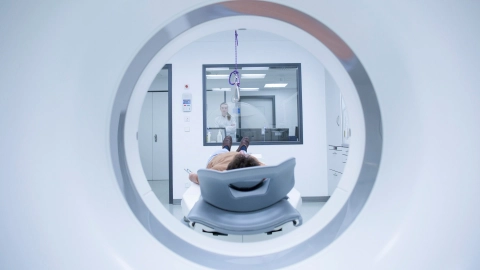Conditions Brain tumors
ICD codes: C70 C71 C72 What are ICD codes?
Primary brain tumors arise directly from brain tissue. They are different from brain metastases – these are metastases in the brain from a cancer that originated in a different organ. This article provides an overview of the risk factors, diagnosis, and treatment of brain tumors.
At a glance
- Primary tumors that develop directly from brain tissue are rare.
- There are many different types of brain tumors.
- The symptoms of a brain tumor mainly depend on how big the tumor is and where it is in the brain.
- Surgery, radiotherapy and/or chemotherapy are options for the treatment of brain tumors, as are targeted drugs, depending on the individual case. Some patients may also receive new experimental treatments as part of clinical trials.
- What support and follow-up tests brain tumor patients need after treatment depends on the situation regarding their condition.
Note: The information in this article cannot and should not replace a medical consultation and must not be used for self-diagnosis or treatment.

What is a brain tumor?
Primary brain tumors develop from brain cells. There are different types of brain tumors that start from different cell types. They can be benign (non-cancerous) or malignant (cancerous).
Experts also refer to these and tumors in the spinal cord, meninges and spinal cord membranes and cranial nerves as central nervous system (CNS) tumors.
What are benign and malignant brain tumors?
Benign and malignant brain tumors can arise from the various types of tissue.
Unlike benign tumors, malignant tumors grow into the surrounding tissue. This usually makes it impossible to completely remove them.
Examples of malignant tumors of the central nervous system:
- glioblastoma
- diffuse astrocytoma
- diffuse oligodendroglioma
- medulloblastoma
Malignant tumors of the lymph system (malignant lymphomas) can also occur in the brain.
Benign brain tumors can also cause symptoms as they grow. But they don’t spread to other parts and can usually be removed completely.
Examples of benign tumors of the central nervous system:
- meningioma
- neurinoma/schwannoma
- pilocytic astrocytoma
Important: Pituitary adenomas are also common benign tumors in the pituitary gland. They are not formally categorized as tumors of the central nervous system, but tumors of the hormonal system (endocrine tumors).
Based on which characteristics are brain tumors categorized?
Brain tumors are differentiated as follows:
- By their cell type of origin: brain tumors most often start from the supporting cells of the brain known as glial cells. Physicians refer to these tumors as gliomas.
- By their genetic changes (mutations): These are often of critical importance to doctors in assessing how the disease is progressing and in planning treatment. However, these changes depend entirely on the type of brain tumor involved. In the case of gliomas, for example, changes occur in the IDH gene.
- By their growth behavior and prognosis: To describe how quickly (aggressively) a brain tumor is growing and how this influences the likely course of the disease, experts use the CNS-WHO grades 1 (slow growing, localized tumor) to 4 (fast-growing aggressive tumor).
Important: It’s not a primary brain tumor if doctors are talking of “metastases” in the brain. This is because brain metastases arise from a tumor that has developed outside the brain. Specialists therefore also refer to them as secondary brain tumors. Metastases in the brain are usually treated differently from primary brain tumors.
What are the symptoms of brain tumors?
Brain tumors can cause a variety of symptoms. They can occur individually or in combination. Some symptoms will depend on where exactly the tumor is in the brain.

Brain tumors can trigger a wide range of symptoms that also depend on the position of the tumor. Symptoms such as headaches and nausea may also occur in people with other harmless diseases. Anyone who has a new headache or new type of headache should consult their doctor.
Possible signs of a brain tumor are:
- New onset of epileptic seizures: seizures are often the first symptom with many types of brain tumor.
- Increased pressure on the brain: this typically manifests itself through symptoms such as headache, nausea, vomiting or impaired consciousness.
- Neurological deficits: they manifest themselves for example through signs of paralysis, dizziness or sensory disturbances (for example seeing or hearing).
- Behavioral changes: personality changes, disorientation or difficulties in concentrating.
Brain tumors: what are the causes and risk factors?
What causes different brain tumors to develop is still largely unclear. Despite extensive research it is also still not very well known what makes brain tumors more likely. Only few people with brain tumors have a history of the risk factors known of to date. Experts therefore believe that brain tumors arise mostly by chance, due to errors in cell division in individual cells of the brain.
Video What is cancer?
The video below explains when doctors talk about cancer and how cancer occurs.
This and other videos can also be found on YouTube
Watch nowThe privacy policy indicated there applies.
The risk of brain tumors increases:
- With certain genetic diseases, including hereditary cancer syndromes such as Lynch syndrome and Li-Fraumeni syndrome or diseases such as neurofibromatosis or tuberous sclerosis.
- With family history: first-degree relatives of young patients with the cancer have a slightly increased risk of also developing a brain tumor.
- With therapeutic radiotherapy: in adults and, in particular, children and adolescents who have received radiotherapy of the cranium or in the head and neck area, the risk of developing a brain tumor is increased. However, the brain tumors usually only develop many years after radiotherapy.
- With computed tomography (CT) scans in childhood: The risk of developing brain tumors is increased slightly for children who have had this type of scan of the head and neck area.
Research: what can scientists still not make a reliable statement about?
Environmental factors and lifestyle
It is not yet clear whether an infection with certain viruses, damaging substances, smoking or alcohol increase the risk of brain tumors.
Mobile phones
Scientists have not yet established any clear link between the use of mobile phones and the development of brain tumors. It has also not yet been clearly proven whether long and frequent use of mobile phones increases the risk of brain tumors. But experts cannot unequivocally rule it out.
How common are brain tumors?
In Germany, about 7,300 people develop malignant cancer of the central nervous system every year. Men get it on average at the age of 63, women on average at the age of 66. But anyone of any age can get CNS tumors.
Glioblastomas are the most common malignant primary brain tumor in adults – two-thirds of people with a malignant CNS tumor have a glioblastoma.
Is it possible to screen for brain tumors?
A statutory brain tumor screening program doesn’t yet exist. One reason for this is that malignant tumors are not very common. In addition, some brain tumors can grow quickly within just a few weeks.
Exceptions apply to risk groups with hereditary tumor diseases (tumor syndromes) that make brain tumors more likely – people who have these should have regular check-ups using imaging procedures to screen for a brain tumor. Magnetic resonance imaging (MRI) is generally used for this purpose.
What tests are used to diagnose brain tumors?
There are different and complementary diagnostic procedures available to doctors if they suspect a brain tumor.
The doctor usually starts by asking the patient about any pre-existing conditions, their lifestyle habits and whether they have any symptoms and how they are developing. Health professionals call this medical history.
Once the doctor has gathered someone’s medical history, this is followed by clinical tests to assess the patient’s sensory perception, alertness, and memory.
If a brain tumor is suspected, the imaging procedure of choice is magnetic resonance imaging (MRI). The following imaging procedures are suitable for carrying out additionally before tumor surgery:
- computed tomography (CT)
- angiography
- positron emission tomography (PET)
- special magnetic resonance tomography procedures, for instance magnetic resonance spectroscopy (MRS)
To confirm the diagnosis of a brain tumor, doctors normally have to take a sample of the tumor tissue (biopsy). In the laboratory, specialists look at the tissue sample under a microscope and determine the type of tumor. They also examine the genetic make-up of the tumor cells for various genetic mutations. This helps the doctors to assess how well the tumor might respond to certain treatments, and use it as a basis to plan the treatment effectively.
The following types of biopsy are options for people with a brain tumor:
- targeted tissue removal known as stereotactic biopsy
- sampling the tumor tissue during tumor surgery
Do you want to know more about the process, the techniques and the possible risks of the imaging tests mentioned? You can find an initial overview on the Cancer Information Service of the German Cancer Research Center website (in German).
How are brain tumors treated?
The treatment that is most appropriate differs for the different types of brain tumor. The treatment can therefore differ from patient to patient depending on the brain tumor type.
The choice of treatment will depend on the following factors:
- the tissue of origin
- the genetic characteristics of the tumor
- the growth rate of the tumor
- the location of the tumor in the brain
- the age of the person affected
- the general state of the patient’s health
- the comorbidities

Depending on the factors mentioned, doctors usually remove the brain tumor during surgery as far as is possible. If there is a malignant tumor, the person affected then undergoes further treatment – usually this is radiotherapy, chemotherapy or a combination of the two. Some patients may also receive targeted drug therapy. This is medication targeting specific characteristics of the cancer cells.
How can those affected get access to new ways of treatment?
Depending on the situation regarding their condition, a patient can also receive new treatments that are still considered experimental. They can potentially slow down the progression of the disease but have not yet been approved. For this reason, experts recommend that these therapies should preferably be used in the context of clinical trials.
Supportive treatment
In addition to the treatment given to the brain tumor, those affected also receive supportive treatment. It relieves or prevents symptoms that can occur as a result of the treatment or the cancer. These symptoms include, for example:
- headaches
- nausea and vomiting
- epileptic seizures
- brain swelling (brain edema)
Treating these symptoms can improve the patient’s quality of life.
The treatment of brain tumors is very complex and can vary depending on the individual. Prognosis, symptoms, and treatment side effects can vary widely between individual patients. If you go to the Cancer Information Service of the German Cancer Research Center you will obtain reliable information about the treatment of individual brain tumors tailored to your personal situation (in German).
Rehabilitation after the treatment of a brain tumor
If patients show neurological symptoms, doctors start checking early on whether and how they can be improved. Those affected and their relatives can also make use of psycho-oncological support. It can help them to cope with their cancer and the effects of treatment as best they can.
A medical rehab program following treatment for a brain tumor might include:
- speech therapy
- occupational therapy
- physiotherapy
- neurocognitive training programs
What happens after the treatment?
Once the patient has been treated, follow-up tests are used to detect and treat a relapse of the disease and treat the effects of the treatment at an early stage.
If the brain tumor is treated with a view to curing it, experts recommend a structured follow-up examination. This involves asking the patient for their medical history and performing a physical examination and also magnetic resonance imaging (MRI) at regular intervals.
It varies how often patients have to be examined. The greater the risk that the brain tumor will grow again or new symptoms occur, the more frequently the check-ups are usually scheduled.
A treatment with the aim of cure was not possible? The follow-up examinations help to keep an eye on how the disease is progressing. Regular care also ensures that distressing symptoms are recognized early on and can be relieved. The aim is to maintain the patient’s quality of life for as long as possible.
What effect does a brain tumor have on everyday life?
The limitations of a person with a brain tumor depend on several factors, such as:
- the type of tumor
- its location in the brain
- the stage of the disease
- the person’s general health
- the type of treatment
- the effects of the treatment
The progression of the tumor is not the only thing that can be distressing for a patient. Possible disturbances in brain function can also be worrying. These include impairments in perception, learning, remembering, thinking, but also speaking or the coordination of sensory perception and movement.
These disturbances can be caused by the disease itself or the treatment carried out. Rehabilitation and supportive treatments can support a patient in improving these functions again.
Points of contact about brain tumors
Doctors of various specialties work closely together in the treatment of brain tumors. Hospitals that have a lot of experience in the treatment of patients with brain tumors can have this confirmed with certification as an oncological center with the neuro-oncology module. The German Cancer Society (DKG) regularly checks their compliance with certain professional requirements.
You can find the addresses of the certified centers on the OncoMAP website. To do this, select “Neuro-oncology” in the search panel under “Centre”.
The Neuro-oncological Working Group (NOA) of the German Cancer Society (Deutsche Krebsgesellschaft e. V.) can provide support with finding a suitable treatment center. Its members come from different medical fields and all are involved in the care of patients with brain tumors. Many doctors in the NOA can be contacted by email, telephone or if necessary in person for consultations.
The NOA recommends that anyone with queries relating to brain tumors and their treatment should contact a local research center. The NOA website has an interactive map showing where these centers are located in Germany.
Do you have further questions about dealing with the condition in everyday life and additional support options? You can find information about this on the website of the Cancer Information Service of the German Cancer Research Center (in German).
For all questions about brain tumors, you can also make direct contact with Cancer Information Service doctors by dialing the freephone number (0800) 420 30 40 or by sending an e-mail to krebsinformationsdienst@dkfz.de.
- Wick W. et al., Gliome, S2k-Leitlinie, 2021, in: Deutsche Gesellschaft für Neurologie (Hrsg.), Leitlinien für Diagnostik und Therapie in der Neurologie. AWMF-Registernummer: 033/099. 02.2021. Aufgerufen am 10.01.2024.
- Zentrum für Krebsregisterdaten (ZfKD) des Robert Koch-Instituts (RKI). Krebs des Zentralen Nervensystems. Aufgerufen am 10.01.2024.
In cooperation with the Cancer Information Service of the German Cancer Research Center (Krebsinformationsdienst des Deutschen Krebsforschungszentrums).
As at:





